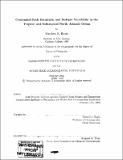Centennial-scale elemental and isotopic variability in the tropical and subtropical North Atlantic Ocean
Author(s)
Reuer, Matthew K. (Matthew Kindt), 1972-
DownloadFull printable version (15.16Mb)
Other Contributors
Woods Hole Oceanographic Institution.
Advisor
Edward A. Boyle.
Terms of use
Metadata
Show full item recordAbstract
The marine geochemistry of the North Atlantic Ocean varies on decadal to centennial time scales, a consequence of natural and anthropogenic forcing. Surface corals provide a useful geochemical archive to quantify past mixed layer variability, and this study presents elemental and isotopic records from the tropical and subtropical North Atlantic. A consistent method for stable lead isotope analysis via multiple collector ICP-MS is first presented. This method is then applied to western North Atlantic surface corals and seawater, constraining historical elemental and isotopic lead variability. Six stable lead isotope profiles are developed from the western and eastern North Atlantic, demonstrating consistent mixed layer, thermocline, and deep water variability. Finally, coralline trace element records, including cadmium, barium, and lead, are presented from the Cariaco Basin. First, a reliable method is developed for stable lead isotope analysis by multiple collector ICP-MS. This study presents new observations of the large (0.7% amu-l), time-dependent mass fractionation determined by thallium normalization, including preferential light ion transmission induced by the acceleration potential and nebulizer conditions. These experiments show equivalent results for three empirical correction laws, and the previously proposed [beta]Pb/[beta]TI correction does not improve isotope ratio accuracy under these conditions. External secondary normalization to SRM-981 provides one simple alternative, and a rationale is provided for this correction. With current intensities less than 1.5x10-12 A, external isotope ratio precision less than 200 ppm is observed (2[sigma]). Matrix effects are significant with concomitant calcium in SRM-981 (-280 ppm at 257 [mu]M [Ca]). (cont.) With the appropriate corrections and minimal concomitants, MC-ICP-MS can reliably determine 206Pb/207Pb and 208Pb/207Pb ratios of marine carbonates and seawater. Anthropogenic lead represents a promising transient oceanographic tracer, and its historical isotopic and elemental North Atlantic variability have been documented by proxy reconstructions and seawater observations. Two high-resolution surface coral and seawater time series from the western North Atlantic are presented, demonstrating past variability consistent with upper ocean observations. The elemental reconstruction suggests the primary lead transient was advected to the western North Atlantic from 1955 to 1968, with an inferred maximum lead concentration of 205 pmol kg-1 in 1971. The mean 1999 North Atlantic seawater concentration (38 pmol kg-1) is equivalent to 1905, several decades prior to the initial consumption of leaded gasoline in the United States. A 206Pb/207Pb transient from 1968 to 1990 is also observed, lagging the elemental transient by ten years. The provenance of this isotopic record is distinct from Arctic and European ice core observations and supports a 40% ...
Description
Thesis (Ph.D.)--Joint Program in Oceanography/Applied Ocean Science and Engineering (Massachusetts Institute of Technology, Dept. of Earth, Atmospheric, and Planetary Sciences; and the Woods Hole Oceanographic Institution), 2002. Includes bibliographical references (leaves 169-187).
Date issued
2002Department
Joint Program in Oceanography/Applied Ocean Science and Engineering; Woods Hole Oceanographic Institution; Massachusetts Institute of Technology. Department of Ocean EngineeringPublisher
Massachusetts Institute of Technology
Keywords
/Woods Hole Oceanographic Institution. Joint Program in Oceanography/Applied Ocean Science and Engineering., Earth, Atmospheric, and Planetary Sciences., Woods Hole Oceanographic Institution.